Enhance College of Technology Food Safety Program Project
VerifiedAdded on 2022/08/17
|22
|4874
|13
Project
AI Summary
This project, conducted at Enhance College of Technology, assesses a student's competency in developing, implementing, monitoring, and evaluating a comprehensive food safety program. The assessment requires students to answer questions related to food safety, cookery methods, and kitchen operations. Students are expected to demonstrate knowledge of culinary terms, quality indicators, and safe operational practices. The project covers various aspects of food preparation, including handling vegetables, fruits, eggs, and farinaceous items, alongside different cookery methods. Students must follow standard recipes, adhere to portion control, and respond to customer requests, all while maintaining food safety standards. The assessment also includes oral questioning to evaluate the student's underpinning knowledge, focusing on topics like ingredient characteristics, environmental conditions, and equipment usage. Successful completion requires proficiency in commercial cookery, adherence to time constraints, and a strong understanding of food safety protocols.
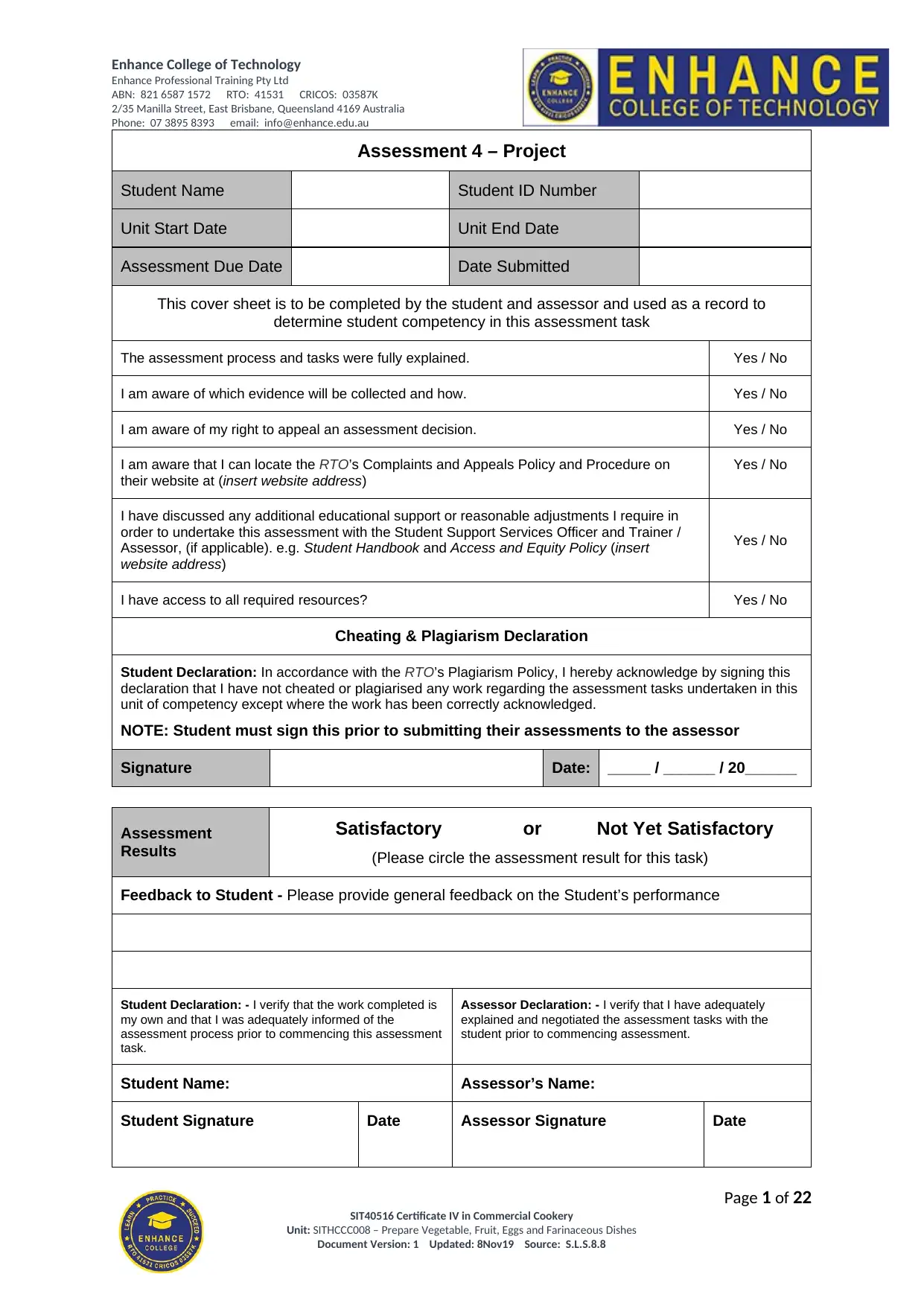
Enhance College of Technology
Enhance Professional Training Pty Ltd
ABN: 821 6587 1572 RTO: 41531 CRICOS: 03587K
2/35 Manilla Street, East Brisbane, Queensland 4169 Australia
Phone: 07 3895 8393 email: info@enhance.edu.au
Assessment 4 – Project
Student Name Student ID Number
Unit Start Date Unit End Date
Assessment Due Date Date Submitted
This cover sheet is to be completed by the student and assessor and used as a record to
determine student competency in this assessment task
The assessment process and tasks were fully explained. Yes / No
I am aware of which evidence will be collected and how. Yes / No
I am aware of my right to appeal an assessment decision. Yes / No
I am aware that I can locate the RTO’s Complaints and Appeals Policy and Procedure on
their website at (insert website address)
Yes / No
I have discussed any additional educational support or reasonable adjustments I require in
order to undertake this assessment with the Student Support Services Officer and Trainer /
Assessor, (if applicable). e.g. Student Handbook and Access and Equity Policy (insert
website address)
Yes / No
I have access to all required resources? Yes / No
Cheating & Plagiarism Declaration
Student Declaration: In accordance with the RTO’s Plagiarism Policy, I hereby acknowledge by signing this
declaration that I have not cheated or plagiarised any work regarding the assessment tasks undertaken in this
unit of competency except where the work has been correctly acknowledged.
NOTE: Student must sign this prior to submitting their assessments to the assessor
Signature Date: _____ / ______ / 20______
Assessment
Results
Satisfactory or Not Yet Satisfactory
(Please circle the assessment result for this task)
Feedback to Student - Please provide general feedback on the Student’s performance
Student Declaration: - I verify that the work completed is
my own and that I was adequately informed of the
assessment process prior to commencing this assessment
task.
Assessor Declaration: - I verify that I have adequately
explained and negotiated the assessment tasks with the
student prior to commencing assessment.
Student Name: Assessor’s Name:
Student Signature Date Assessor Signature Date
Page 1 of 22
SIT40516 Certificate IV in Commercial Cookery
Unit: SITHCCC008 – Prepare Vegetable, Fruit, Eggs and Farinaceous Dishes
Document Version: 1 Updated: 8Nov19 Source: S.L.S.8.8
Enhance Professional Training Pty Ltd
ABN: 821 6587 1572 RTO: 41531 CRICOS: 03587K
2/35 Manilla Street, East Brisbane, Queensland 4169 Australia
Phone: 07 3895 8393 email: info@enhance.edu.au
Assessment 4 – Project
Student Name Student ID Number
Unit Start Date Unit End Date
Assessment Due Date Date Submitted
This cover sheet is to be completed by the student and assessor and used as a record to
determine student competency in this assessment task
The assessment process and tasks were fully explained. Yes / No
I am aware of which evidence will be collected and how. Yes / No
I am aware of my right to appeal an assessment decision. Yes / No
I am aware that I can locate the RTO’s Complaints and Appeals Policy and Procedure on
their website at (insert website address)
Yes / No
I have discussed any additional educational support or reasonable adjustments I require in
order to undertake this assessment with the Student Support Services Officer and Trainer /
Assessor, (if applicable). e.g. Student Handbook and Access and Equity Policy (insert
website address)
Yes / No
I have access to all required resources? Yes / No
Cheating & Plagiarism Declaration
Student Declaration: In accordance with the RTO’s Plagiarism Policy, I hereby acknowledge by signing this
declaration that I have not cheated or plagiarised any work regarding the assessment tasks undertaken in this
unit of competency except where the work has been correctly acknowledged.
NOTE: Student must sign this prior to submitting their assessments to the assessor
Signature Date: _____ / ______ / 20______
Assessment
Results
Satisfactory or Not Yet Satisfactory
(Please circle the assessment result for this task)
Feedback to Student - Please provide general feedback on the Student’s performance
Student Declaration: - I verify that the work completed is
my own and that I was adequately informed of the
assessment process prior to commencing this assessment
task.
Assessor Declaration: - I verify that I have adequately
explained and negotiated the assessment tasks with the
student prior to commencing assessment.
Student Name: Assessor’s Name:
Student Signature Date Assessor Signature Date
Page 1 of 22
SIT40516 Certificate IV in Commercial Cookery
Unit: SITHCCC008 – Prepare Vegetable, Fruit, Eggs and Farinaceous Dishes
Document Version: 1 Updated: 8Nov19 Source: S.L.S.8.8
Paraphrase This Document
Need a fresh take? Get an instant paraphrase of this document with our AI Paraphraser
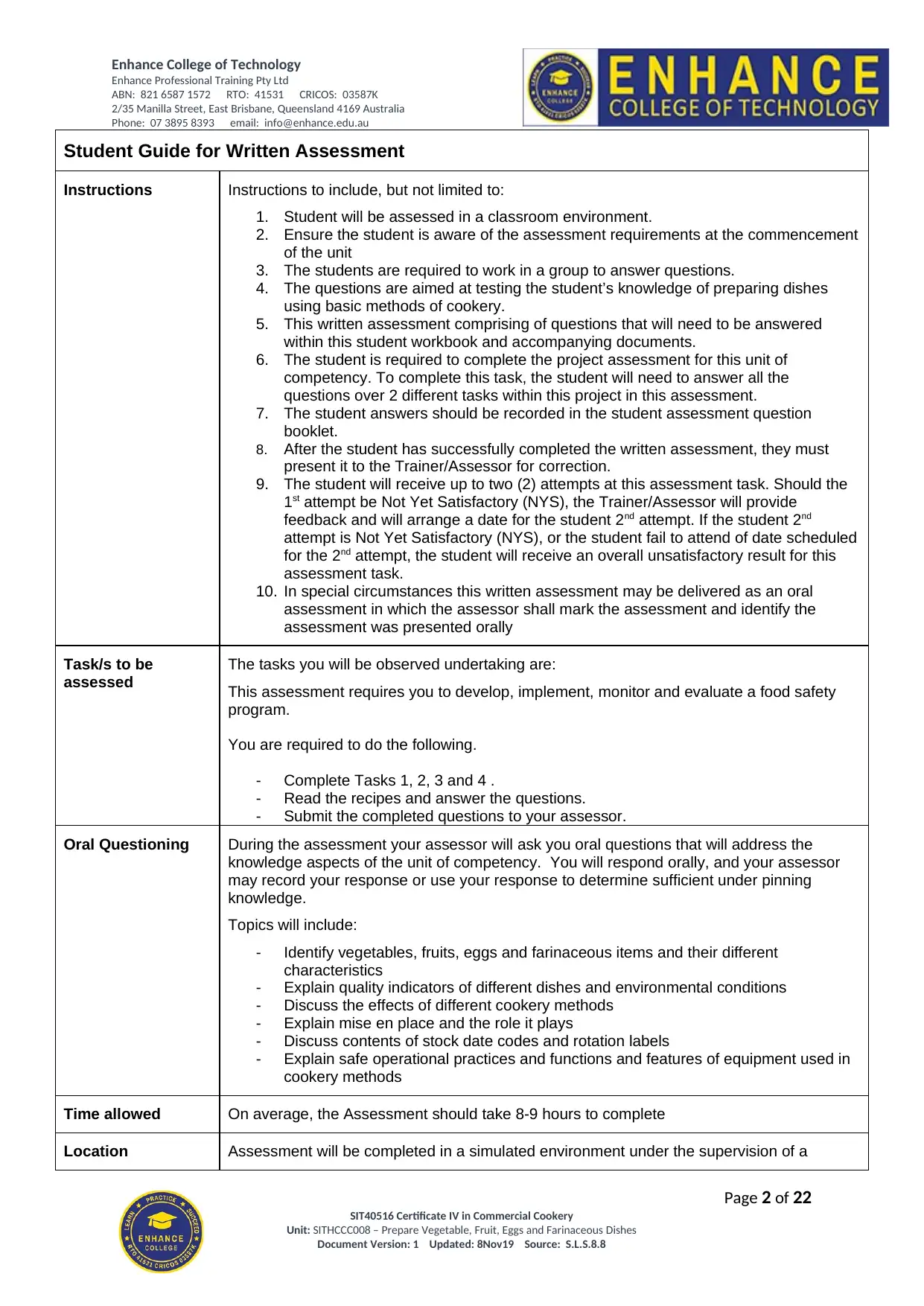
Enhance College of Technology
Enhance Professional Training Pty Ltd
ABN: 821 6587 1572 RTO: 41531 CRICOS: 03587K
2/35 Manilla Street, East Brisbane, Queensland 4169 Australia
Phone: 07 3895 8393 email: info@enhance.edu.au
Student Guide for Written Assessment
Instructions Instructions to include, but not limited to:
1. Student will be assessed in a classroom environment.
2. Ensure the student is aware of the assessment requirements at the commencement
of the unit
3. The students are required to work in a group to answer questions.
4. The questions are aimed at testing the student’s knowledge of preparing dishes
using basic methods of cookery.
5. This written assessment comprising of questions that will need to be answered
within this student workbook and accompanying documents.
6. The student is required to complete the project assessment for this unit of
competency. To complete this task, the student will need to answer all the
questions over 2 different tasks within this project in this assessment.
7. The student answers should be recorded in the student assessment question
booklet.
8. After the student has successfully completed the written assessment, they must
present it to the Trainer/Assessor for correction.
9. The student will receive up to two (2) attempts at this assessment task. Should the
1st attempt be Not Yet Satisfactory (NYS), the Trainer/Assessor will provide
feedback and will arrange a date for the student 2nd attempt. If the student 2nd
attempt is Not Yet Satisfactory (NYS), or the student fail to attend of date scheduled
for the 2nd attempt, the student will receive an overall unsatisfactory result for this
assessment task.
10. In special circumstances this written assessment may be delivered as an oral
assessment in which the assessor shall mark the assessment and identify the
assessment was presented orally
Task/s to be
assessed
The tasks you will be observed undertaking are:
This assessment requires you to develop, implement, monitor and evaluate a food safety
program.
You are required to do the following.
- Complete Tasks 1, 2, 3 and 4 .
- Read the recipes and answer the questions.
- Submit the completed questions to your assessor.
Oral Questioning During the assessment your assessor will ask you oral questions that will address the
knowledge aspects of the unit of competency. You will respond orally, and your assessor
may record your response or use your response to determine sufficient under pinning
knowledge.
Topics will include:
- Identify vegetables, fruits, eggs and farinaceous items and their different
characteristics
- Explain quality indicators of different dishes and environmental conditions
- Discuss the effects of different cookery methods
- Explain mise en place and the role it plays
- Discuss contents of stock date codes and rotation labels
- Explain safe operational practices and functions and features of equipment used in
cookery methods
Time allowed On average, the Assessment should take 8-9 hours to complete
Location Assessment will be completed in a simulated environment under the supervision of a
Page 2 of 22
SIT40516 Certificate IV in Commercial Cookery
Unit: SITHCCC008 – Prepare Vegetable, Fruit, Eggs and Farinaceous Dishes
Document Version: 1 Updated: 8Nov19 Source: S.L.S.8.8
Enhance Professional Training Pty Ltd
ABN: 821 6587 1572 RTO: 41531 CRICOS: 03587K
2/35 Manilla Street, East Brisbane, Queensland 4169 Australia
Phone: 07 3895 8393 email: info@enhance.edu.au
Student Guide for Written Assessment
Instructions Instructions to include, but not limited to:
1. Student will be assessed in a classroom environment.
2. Ensure the student is aware of the assessment requirements at the commencement
of the unit
3. The students are required to work in a group to answer questions.
4. The questions are aimed at testing the student’s knowledge of preparing dishes
using basic methods of cookery.
5. This written assessment comprising of questions that will need to be answered
within this student workbook and accompanying documents.
6. The student is required to complete the project assessment for this unit of
competency. To complete this task, the student will need to answer all the
questions over 2 different tasks within this project in this assessment.
7. The student answers should be recorded in the student assessment question
booklet.
8. After the student has successfully completed the written assessment, they must
present it to the Trainer/Assessor for correction.
9. The student will receive up to two (2) attempts at this assessment task. Should the
1st attempt be Not Yet Satisfactory (NYS), the Trainer/Assessor will provide
feedback and will arrange a date for the student 2nd attempt. If the student 2nd
attempt is Not Yet Satisfactory (NYS), or the student fail to attend of date scheduled
for the 2nd attempt, the student will receive an overall unsatisfactory result for this
assessment task.
10. In special circumstances this written assessment may be delivered as an oral
assessment in which the assessor shall mark the assessment and identify the
assessment was presented orally
Task/s to be
assessed
The tasks you will be observed undertaking are:
This assessment requires you to develop, implement, monitor and evaluate a food safety
program.
You are required to do the following.
- Complete Tasks 1, 2, 3 and 4 .
- Read the recipes and answer the questions.
- Submit the completed questions to your assessor.
Oral Questioning During the assessment your assessor will ask you oral questions that will address the
knowledge aspects of the unit of competency. You will respond orally, and your assessor
may record your response or use your response to determine sufficient under pinning
knowledge.
Topics will include:
- Identify vegetables, fruits, eggs and farinaceous items and their different
characteristics
- Explain quality indicators of different dishes and environmental conditions
- Discuss the effects of different cookery methods
- Explain mise en place and the role it plays
- Discuss contents of stock date codes and rotation labels
- Explain safe operational practices and functions and features of equipment used in
cookery methods
Time allowed On average, the Assessment should take 8-9 hours to complete
Location Assessment will be completed in a simulated environment under the supervision of a
Page 2 of 22
SIT40516 Certificate IV in Commercial Cookery
Unit: SITHCCC008 – Prepare Vegetable, Fruit, Eggs and Farinaceous Dishes
Document Version: 1 Updated: 8Nov19 Source: S.L.S.8.8
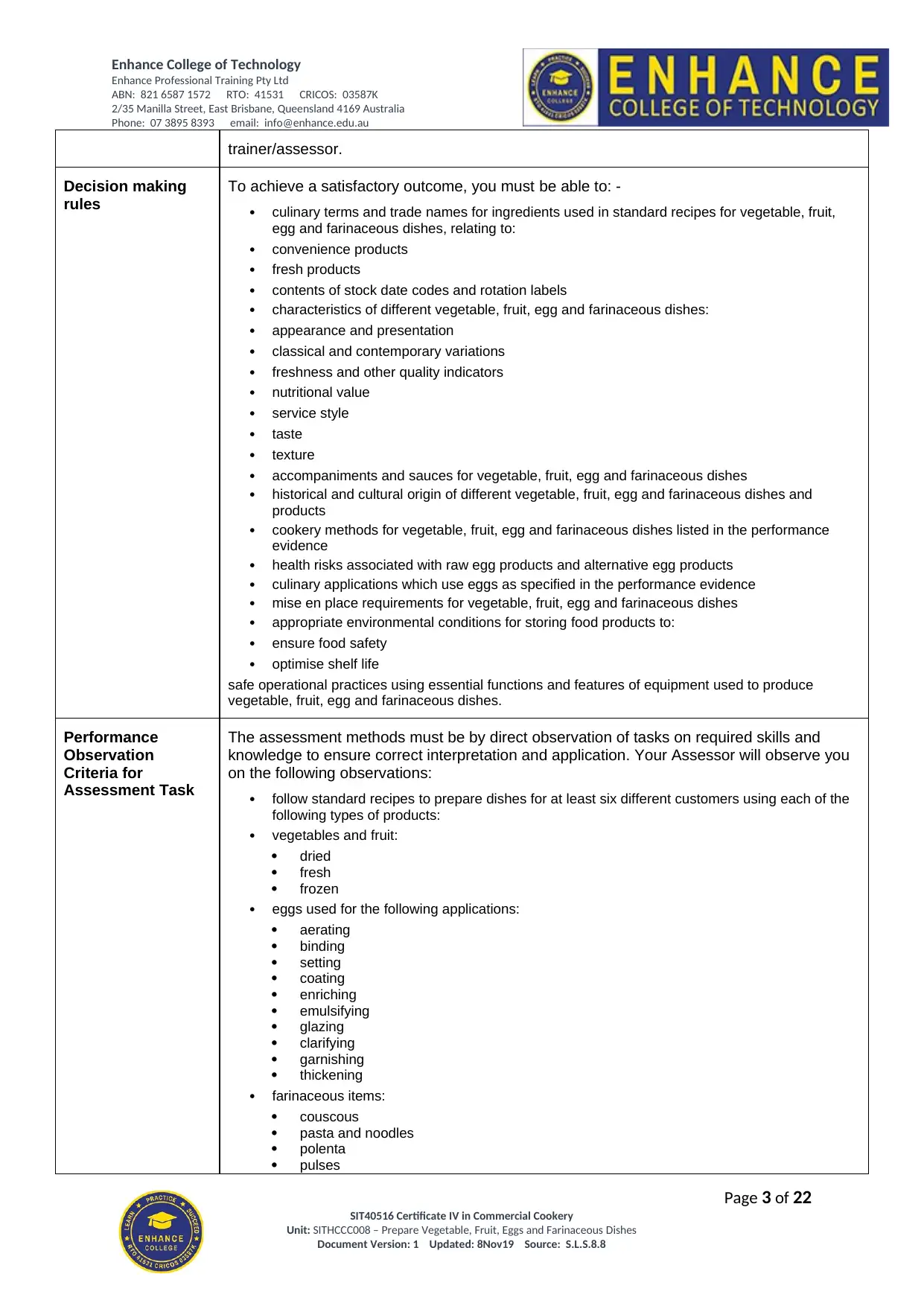
Enhance College of Technology
Enhance Professional Training Pty Ltd
ABN: 821 6587 1572 RTO: 41531 CRICOS: 03587K
2/35 Manilla Street, East Brisbane, Queensland 4169 Australia
Phone: 07 3895 8393 email: info@enhance.edu.au
trainer/assessor.
Decision making
rules
To achieve a satisfactory outcome, you must be able to: -
culinary terms and trade names for ingredients used in standard recipes for vegetable, fruit,
egg and farinaceous dishes, relating to:
convenience products
fresh products
contents of stock date codes and rotation labels
characteristics of different vegetable, fruit, egg and farinaceous dishes:
appearance and presentation
classical and contemporary variations
freshness and other quality indicators
nutritional value
service style
taste
texture
accompaniments and sauces for vegetable, fruit, egg and farinaceous dishes
historical and cultural origin of different vegetable, fruit, egg and farinaceous dishes and
products
cookery methods for vegetable, fruit, egg and farinaceous dishes listed in the performance
evidence
health risks associated with raw egg products and alternative egg products
culinary applications which use eggs as specified in the performance evidence
mise en place requirements for vegetable, fruit, egg and farinaceous dishes
appropriate environmental conditions for storing food products to:
ensure food safety
optimise shelf life
safe operational practices using essential functions and features of equipment used to produce
vegetable, fruit, egg and farinaceous dishes.
Performance
Observation
Criteria for
Assessment Task
The assessment methods must be by direct observation of tasks on required skills and
knowledge to ensure correct interpretation and application. Your Assessor will observe you
on the following observations:
follow standard recipes to prepare dishes for at least six different customers using each of the
following types of products:
vegetables and fruit:
dried
fresh
frozen
eggs used for the following applications:
aerating
binding
setting
coating
enriching
emulsifying
glazing
clarifying
garnishing
thickening
farinaceous items:
couscous
pasta and noodles
polenta
pulses
Page 3 of 22
SIT40516 Certificate IV in Commercial Cookery
Unit: SITHCCC008 – Prepare Vegetable, Fruit, Eggs and Farinaceous Dishes
Document Version: 1 Updated: 8Nov19 Source: S.L.S.8.8
Enhance Professional Training Pty Ltd
ABN: 821 6587 1572 RTO: 41531 CRICOS: 03587K
2/35 Manilla Street, East Brisbane, Queensland 4169 Australia
Phone: 07 3895 8393 email: info@enhance.edu.au
trainer/assessor.
Decision making
rules
To achieve a satisfactory outcome, you must be able to: -
culinary terms and trade names for ingredients used in standard recipes for vegetable, fruit,
egg and farinaceous dishes, relating to:
convenience products
fresh products
contents of stock date codes and rotation labels
characteristics of different vegetable, fruit, egg and farinaceous dishes:
appearance and presentation
classical and contemporary variations
freshness and other quality indicators
nutritional value
service style
taste
texture
accompaniments and sauces for vegetable, fruit, egg and farinaceous dishes
historical and cultural origin of different vegetable, fruit, egg and farinaceous dishes and
products
cookery methods for vegetable, fruit, egg and farinaceous dishes listed in the performance
evidence
health risks associated with raw egg products and alternative egg products
culinary applications which use eggs as specified in the performance evidence
mise en place requirements for vegetable, fruit, egg and farinaceous dishes
appropriate environmental conditions for storing food products to:
ensure food safety
optimise shelf life
safe operational practices using essential functions and features of equipment used to produce
vegetable, fruit, egg and farinaceous dishes.
Performance
Observation
Criteria for
Assessment Task
The assessment methods must be by direct observation of tasks on required skills and
knowledge to ensure correct interpretation and application. Your Assessor will observe you
on the following observations:
follow standard recipes to prepare dishes for at least six different customers using each of the
following types of products:
vegetables and fruit:
dried
fresh
frozen
eggs used for the following applications:
aerating
binding
setting
coating
enriching
emulsifying
glazing
clarifying
garnishing
thickening
farinaceous items:
couscous
pasta and noodles
polenta
pulses
Page 3 of 22
SIT40516 Certificate IV in Commercial Cookery
Unit: SITHCCC008 – Prepare Vegetable, Fruit, Eggs and Farinaceous Dishes
Document Version: 1 Updated: 8Nov19 Source: S.L.S.8.8
⊘ This is a preview!⊘
Do you want full access?
Subscribe today to unlock all pages.

Trusted by 1+ million students worldwide
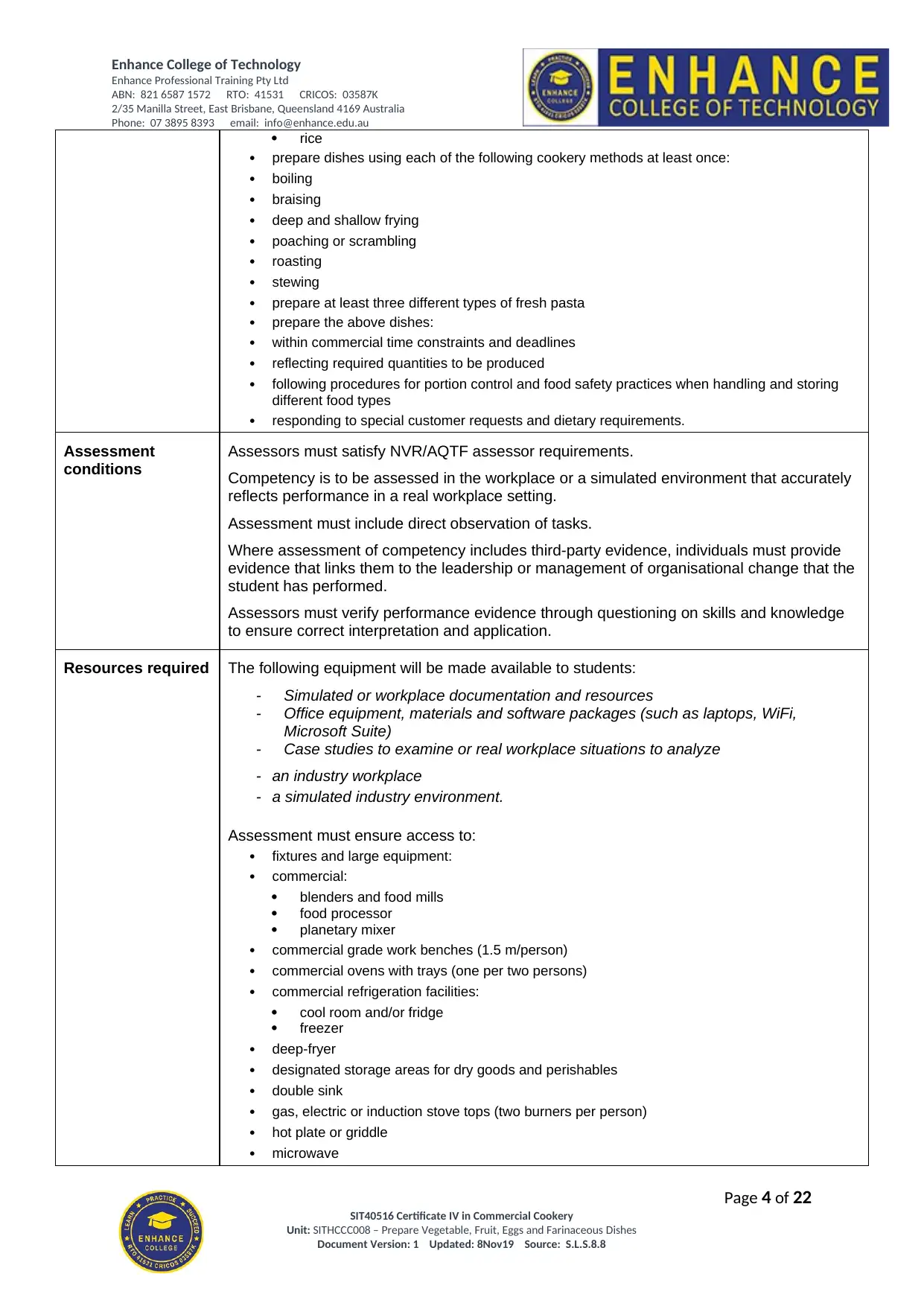
Enhance College of Technology
Enhance Professional Training Pty Ltd
ABN: 821 6587 1572 RTO: 41531 CRICOS: 03587K
2/35 Manilla Street, East Brisbane, Queensland 4169 Australia
Phone: 07 3895 8393 email: info@enhance.edu.au
rice
prepare dishes using each of the following cookery methods at least once:
boiling
braising
deep and shallow frying
poaching or scrambling
roasting
stewing
prepare at least three different types of fresh pasta
prepare the above dishes:
within commercial time constraints and deadlines
reflecting required quantities to be produced
following procedures for portion control and food safety practices when handling and storing
different food types
responding to special customer requests and dietary requirements.
Assessment
conditions
Assessors must satisfy NVR/AQTF assessor requirements.
Competency is to be assessed in the workplace or a simulated environment that accurately
reflects performance in a real workplace setting.
Assessment must include direct observation of tasks.
Where assessment of competency includes third-party evidence, individuals must provide
evidence that links them to the leadership or management of organisational change that the
student has performed.
Assessors must verify performance evidence through questioning on skills and knowledge
to ensure correct interpretation and application.
Resources required The following equipment will be made available to students:
- Simulated or workplace documentation and resources
- Office equipment, materials and software packages (such as laptops, WiFi,
Microsoft Suite)
- Case studies to examine or real workplace situations to analyze
- an industry workplace
- a simulated industry environment.
Assessment must ensure access to:
fixtures and large equipment:
commercial:
blenders and food mills
food processor
planetary mixer
commercial grade work benches (1.5 m/person)
commercial ovens with trays (one per two persons)
commercial refrigeration facilities:
cool room and/or fridge
freezer
deep-fryer
designated storage areas for dry goods and perishables
double sink
gas, electric or induction stove tops (two burners per person)
hot plate or griddle
microwave
Page 4 of 22
SIT40516 Certificate IV in Commercial Cookery
Unit: SITHCCC008 – Prepare Vegetable, Fruit, Eggs and Farinaceous Dishes
Document Version: 1 Updated: 8Nov19 Source: S.L.S.8.8
Enhance Professional Training Pty Ltd
ABN: 821 6587 1572 RTO: 41531 CRICOS: 03587K
2/35 Manilla Street, East Brisbane, Queensland 4169 Australia
Phone: 07 3895 8393 email: info@enhance.edu.au
rice
prepare dishes using each of the following cookery methods at least once:
boiling
braising
deep and shallow frying
poaching or scrambling
roasting
stewing
prepare at least three different types of fresh pasta
prepare the above dishes:
within commercial time constraints and deadlines
reflecting required quantities to be produced
following procedures for portion control and food safety practices when handling and storing
different food types
responding to special customer requests and dietary requirements.
Assessment
conditions
Assessors must satisfy NVR/AQTF assessor requirements.
Competency is to be assessed in the workplace or a simulated environment that accurately
reflects performance in a real workplace setting.
Assessment must include direct observation of tasks.
Where assessment of competency includes third-party evidence, individuals must provide
evidence that links them to the leadership or management of organisational change that the
student has performed.
Assessors must verify performance evidence through questioning on skills and knowledge
to ensure correct interpretation and application.
Resources required The following equipment will be made available to students:
- Simulated or workplace documentation and resources
- Office equipment, materials and software packages (such as laptops, WiFi,
Microsoft Suite)
- Case studies to examine or real workplace situations to analyze
- an industry workplace
- a simulated industry environment.
Assessment must ensure access to:
fixtures and large equipment:
commercial:
blenders and food mills
food processor
planetary mixer
commercial grade work benches (1.5 m/person)
commercial ovens with trays (one per two persons)
commercial refrigeration facilities:
cool room and/or fridge
freezer
deep-fryer
designated storage areas for dry goods and perishables
double sink
gas, electric or induction stove tops (two burners per person)
hot plate or griddle
microwave
Page 4 of 22
SIT40516 Certificate IV in Commercial Cookery
Unit: SITHCCC008 – Prepare Vegetable, Fruit, Eggs and Farinaceous Dishes
Document Version: 1 Updated: 8Nov19 Source: S.L.S.8.8
Paraphrase This Document
Need a fresh take? Get an instant paraphrase of this document with our AI Paraphraser
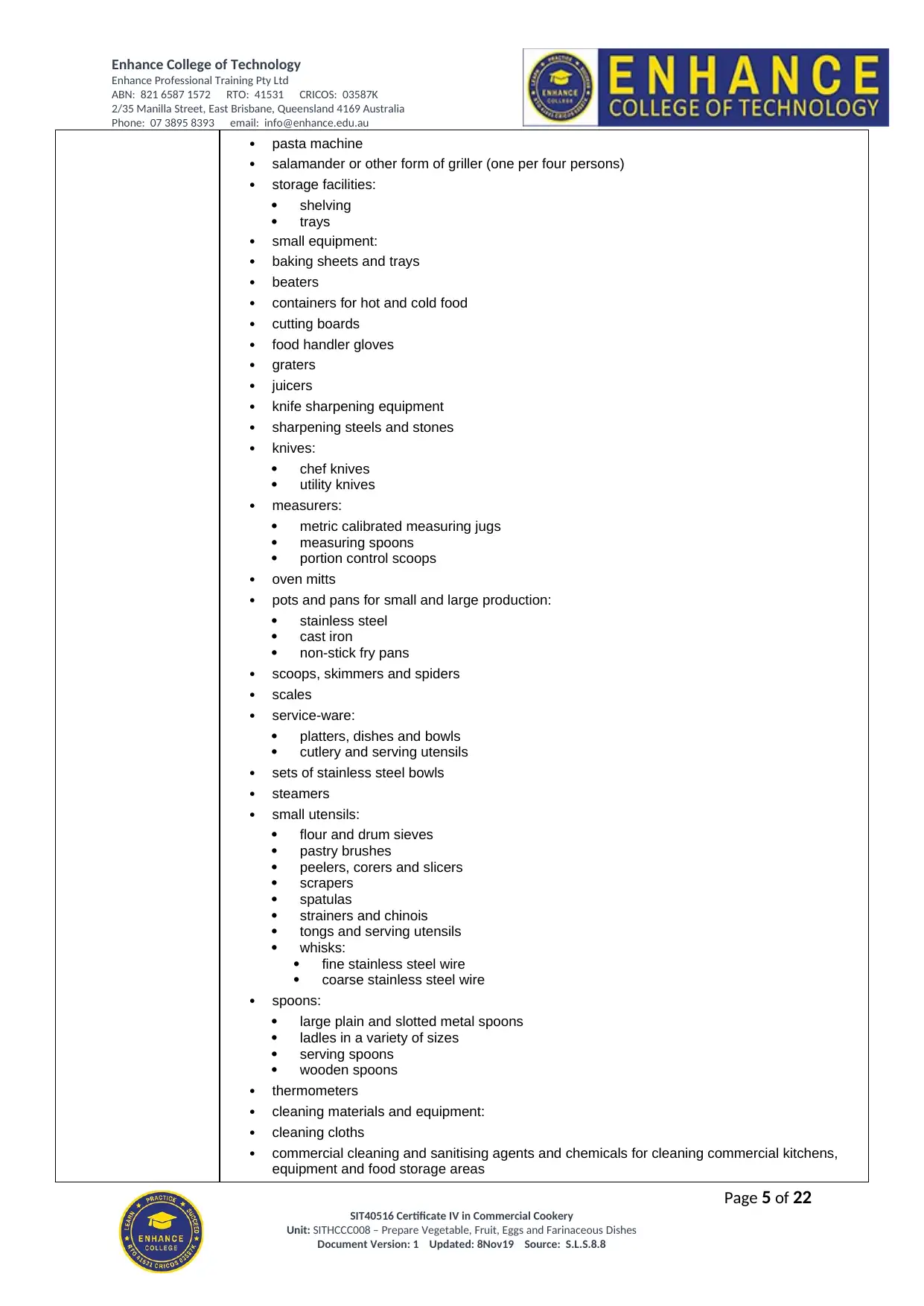
Enhance College of Technology
Enhance Professional Training Pty Ltd
ABN: 821 6587 1572 RTO: 41531 CRICOS: 03587K
2/35 Manilla Street, East Brisbane, Queensland 4169 Australia
Phone: 07 3895 8393 email: info@enhance.edu.au
pasta machine
salamander or other form of griller (one per four persons)
storage facilities:
shelving
trays
small equipment:
baking sheets and trays
beaters
containers for hot and cold food
cutting boards
food handler gloves
graters
juicers
knife sharpening equipment
sharpening steels and stones
knives:
chef knives
utility knives
measurers:
metric calibrated measuring jugs
measuring spoons
portion control scoops
oven mitts
pots and pans for small and large production:
stainless steel
cast iron
non-stick fry pans
scoops, skimmers and spiders
scales
service-ware:
platters, dishes and bowls
cutlery and serving utensils
sets of stainless steel bowls
steamers
small utensils:
flour and drum sieves
pastry brushes
peelers, corers and slicers
scrapers
spatulas
strainers and chinois
tongs and serving utensils
whisks:
fine stainless steel wire
coarse stainless steel wire
spoons:
large plain and slotted metal spoons
ladles in a variety of sizes
serving spoons
wooden spoons
thermometers
cleaning materials and equipment:
cleaning cloths
commercial cleaning and sanitising agents and chemicals for cleaning commercial kitchens,
equipment and food storage areas
Page 5 of 22
SIT40516 Certificate IV in Commercial Cookery
Unit: SITHCCC008 – Prepare Vegetable, Fruit, Eggs and Farinaceous Dishes
Document Version: 1 Updated: 8Nov19 Source: S.L.S.8.8
Enhance Professional Training Pty Ltd
ABN: 821 6587 1572 RTO: 41531 CRICOS: 03587K
2/35 Manilla Street, East Brisbane, Queensland 4169 Australia
Phone: 07 3895 8393 email: info@enhance.edu.au
pasta machine
salamander or other form of griller (one per four persons)
storage facilities:
shelving
trays
small equipment:
baking sheets and trays
beaters
containers for hot and cold food
cutting boards
food handler gloves
graters
juicers
knife sharpening equipment
sharpening steels and stones
knives:
chef knives
utility knives
measurers:
metric calibrated measuring jugs
measuring spoons
portion control scoops
oven mitts
pots and pans for small and large production:
stainless steel
cast iron
non-stick fry pans
scoops, skimmers and spiders
scales
service-ware:
platters, dishes and bowls
cutlery and serving utensils
sets of stainless steel bowls
steamers
small utensils:
flour and drum sieves
pastry brushes
peelers, corers and slicers
scrapers
spatulas
strainers and chinois
tongs and serving utensils
whisks:
fine stainless steel wire
coarse stainless steel wire
spoons:
large plain and slotted metal spoons
ladles in a variety of sizes
serving spoons
wooden spoons
thermometers
cleaning materials and equipment:
cleaning cloths
commercial cleaning and sanitising agents and chemicals for cleaning commercial kitchens,
equipment and food storage areas
Page 5 of 22
SIT40516 Certificate IV in Commercial Cookery
Unit: SITHCCC008 – Prepare Vegetable, Fruit, Eggs and Farinaceous Dishes
Document Version: 1 Updated: 8Nov19 Source: S.L.S.8.8
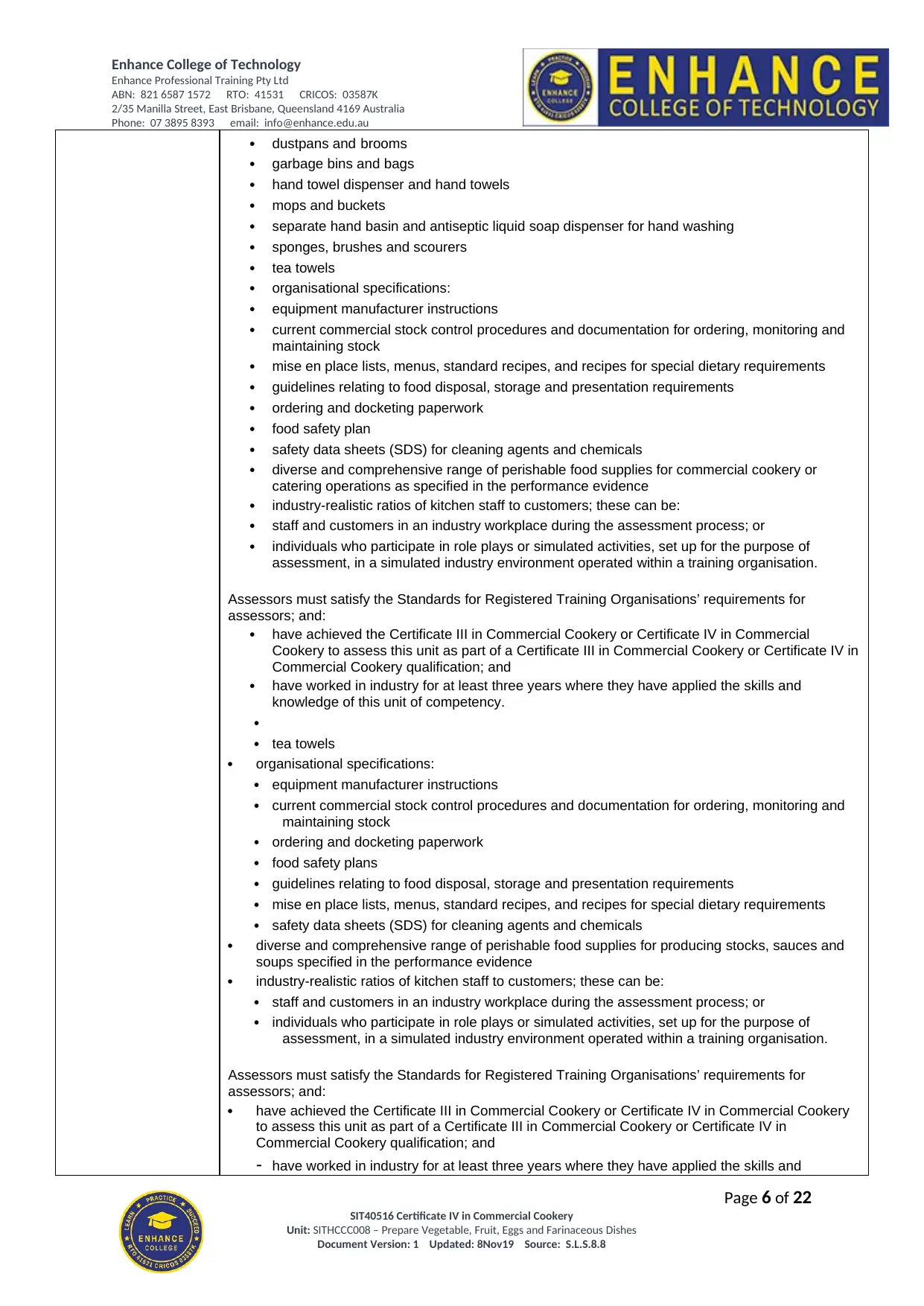
Enhance College of Technology
Enhance Professional Training Pty Ltd
ABN: 821 6587 1572 RTO: 41531 CRICOS: 03587K
2/35 Manilla Street, East Brisbane, Queensland 4169 Australia
Phone: 07 3895 8393 email: info@enhance.edu.au
dustpans and brooms
garbage bins and bags
hand towel dispenser and hand towels
mops and buckets
separate hand basin and antiseptic liquid soap dispenser for hand washing
sponges, brushes and scourers
tea towels
organisational specifications:
equipment manufacturer instructions
current commercial stock control procedures and documentation for ordering, monitoring and
maintaining stock
mise en place lists, menus, standard recipes, and recipes for special dietary requirements
guidelines relating to food disposal, storage and presentation requirements
ordering and docketing paperwork
food safety plan
safety data sheets (SDS) for cleaning agents and chemicals
diverse and comprehensive range of perishable food supplies for commercial cookery or
catering operations as specified in the performance evidence
industry-realistic ratios of kitchen staff to customers; these can be:
staff and customers in an industry workplace during the assessment process; or
individuals who participate in role plays or simulated activities, set up for the purpose of
assessment, in a simulated industry environment operated within a training organisation.
Assessors must satisfy the Standards for Registered Training Organisations’ requirements for
assessors; and:
have achieved the Certificate III in Commercial Cookery or Certificate IV in Commercial
Cookery to assess this unit as part of a Certificate III in Commercial Cookery or Certificate IV in
Commercial Cookery qualification; and
have worked in industry for at least three years where they have applied the skills and
knowledge of this unit of competency.
tea towels
organisational specifications:
equipment manufacturer instructions
current commercial stock control procedures and documentation for ordering, monitoring and
maintaining stock
ordering and docketing paperwork
food safety plans
guidelines relating to food disposal, storage and presentation requirements
mise en place lists, menus, standard recipes, and recipes for special dietary requirements
safety data sheets (SDS) for cleaning agents and chemicals
diverse and comprehensive range of perishable food supplies for producing stocks, sauces and
soups specified in the performance evidence
industry-realistic ratios of kitchen staff to customers; these can be:
staff and customers in an industry workplace during the assessment process; or
individuals who participate in role plays or simulated activities, set up for the purpose of
assessment, in a simulated industry environment operated within a training organisation.
Assessors must satisfy the Standards for Registered Training Organisations’ requirements for
assessors; and:
have achieved the Certificate III in Commercial Cookery or Certificate IV in Commercial Cookery
to assess this unit as part of a Certificate III in Commercial Cookery or Certificate IV in
Commercial Cookery qualification; and
- have worked in industry for at least three years where they have applied the skills and
Page 6 of 22
SIT40516 Certificate IV in Commercial Cookery
Unit: SITHCCC008 – Prepare Vegetable, Fruit, Eggs and Farinaceous Dishes
Document Version: 1 Updated: 8Nov19 Source: S.L.S.8.8
Enhance Professional Training Pty Ltd
ABN: 821 6587 1572 RTO: 41531 CRICOS: 03587K
2/35 Manilla Street, East Brisbane, Queensland 4169 Australia
Phone: 07 3895 8393 email: info@enhance.edu.au
dustpans and brooms
garbage bins and bags
hand towel dispenser and hand towels
mops and buckets
separate hand basin and antiseptic liquid soap dispenser for hand washing
sponges, brushes and scourers
tea towels
organisational specifications:
equipment manufacturer instructions
current commercial stock control procedures and documentation for ordering, monitoring and
maintaining stock
mise en place lists, menus, standard recipes, and recipes for special dietary requirements
guidelines relating to food disposal, storage and presentation requirements
ordering and docketing paperwork
food safety plan
safety data sheets (SDS) for cleaning agents and chemicals
diverse and comprehensive range of perishable food supplies for commercial cookery or
catering operations as specified in the performance evidence
industry-realistic ratios of kitchen staff to customers; these can be:
staff and customers in an industry workplace during the assessment process; or
individuals who participate in role plays or simulated activities, set up for the purpose of
assessment, in a simulated industry environment operated within a training organisation.
Assessors must satisfy the Standards for Registered Training Organisations’ requirements for
assessors; and:
have achieved the Certificate III in Commercial Cookery or Certificate IV in Commercial
Cookery to assess this unit as part of a Certificate III in Commercial Cookery or Certificate IV in
Commercial Cookery qualification; and
have worked in industry for at least three years where they have applied the skills and
knowledge of this unit of competency.
tea towels
organisational specifications:
equipment manufacturer instructions
current commercial stock control procedures and documentation for ordering, monitoring and
maintaining stock
ordering and docketing paperwork
food safety plans
guidelines relating to food disposal, storage and presentation requirements
mise en place lists, menus, standard recipes, and recipes for special dietary requirements
safety data sheets (SDS) for cleaning agents and chemicals
diverse and comprehensive range of perishable food supplies for producing stocks, sauces and
soups specified in the performance evidence
industry-realistic ratios of kitchen staff to customers; these can be:
staff and customers in an industry workplace during the assessment process; or
individuals who participate in role plays or simulated activities, set up for the purpose of
assessment, in a simulated industry environment operated within a training organisation.
Assessors must satisfy the Standards for Registered Training Organisations’ requirements for
assessors; and:
have achieved the Certificate III in Commercial Cookery or Certificate IV in Commercial Cookery
to assess this unit as part of a Certificate III in Commercial Cookery or Certificate IV in
Commercial Cookery qualification; and
- have worked in industry for at least three years where they have applied the skills and
Page 6 of 22
SIT40516 Certificate IV in Commercial Cookery
Unit: SITHCCC008 – Prepare Vegetable, Fruit, Eggs and Farinaceous Dishes
Document Version: 1 Updated: 8Nov19 Source: S.L.S.8.8
⊘ This is a preview!⊘
Do you want full access?
Subscribe today to unlock all pages.

Trusted by 1+ million students worldwide
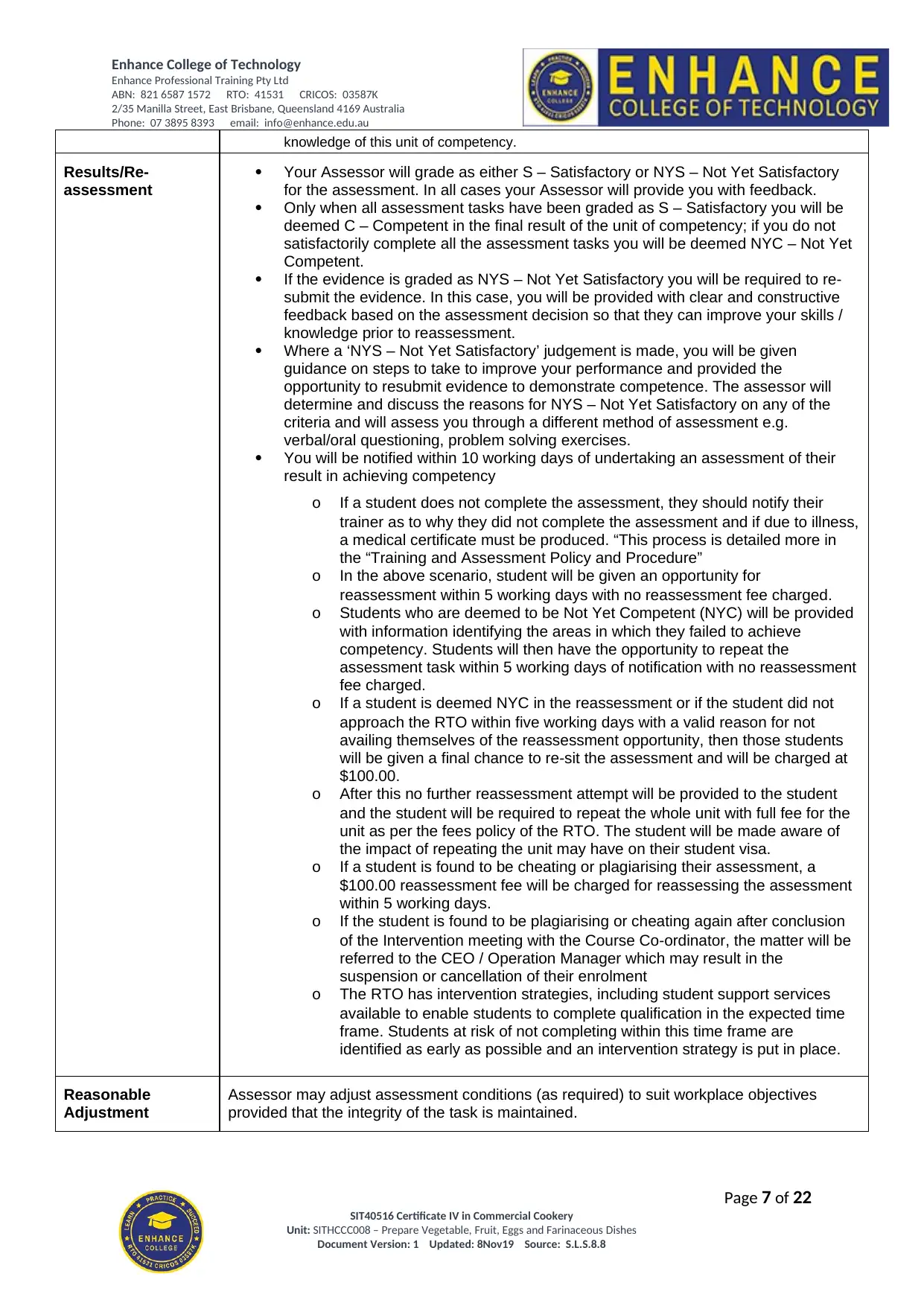
Enhance College of Technology
Enhance Professional Training Pty Ltd
ABN: 821 6587 1572 RTO: 41531 CRICOS: 03587K
2/35 Manilla Street, East Brisbane, Queensland 4169 Australia
Phone: 07 3895 8393 email: info@enhance.edu.au
knowledge of this unit of competency.
Results/Re-
assessment
Your Assessor will grade as either S – Satisfactory or NYS – Not Yet Satisfactory
for the assessment. In all cases your Assessor will provide you with feedback.
Only when all assessment tasks have been graded as S – Satisfactory you will be
deemed C – Competent in the final result of the unit of competency; if you do not
satisfactorily complete all the assessment tasks you will be deemed NYC – Not Yet
Competent.
If the evidence is graded as NYS – Not Yet Satisfactory you will be required to re-
submit the evidence. In this case, you will be provided with clear and constructive
feedback based on the assessment decision so that they can improve your skills /
knowledge prior to reassessment.
Where a ‘NYS – Not Yet Satisfactory’ judgement is made, you will be given
guidance on steps to take to improve your performance and provided the
opportunity to resubmit evidence to demonstrate competence. The assessor will
determine and discuss the reasons for NYS – Not Yet Satisfactory on any of the
criteria and will assess you through a different method of assessment e.g.
verbal/oral questioning, problem solving exercises.
You will be notified within 10 working days of undertaking an assessment of their
result in achieving competency
o If a student does not complete the assessment, they should notify their
trainer as to why they did not complete the assessment and if due to illness,
a medical certificate must be produced. “This process is detailed more in
the “Training and Assessment Policy and Procedure”
o In the above scenario, student will be given an opportunity for
reassessment within 5 working days with no reassessment fee charged.
o Students who are deemed to be Not Yet Competent (NYC) will be provided
with information identifying the areas in which they failed to achieve
competency. Students will then have the opportunity to repeat the
assessment task within 5 working days of notification with no reassessment
fee charged.
o If a student is deemed NYC in the reassessment or if the student did not
approach the RTO within five working days with a valid reason for not
availing themselves of the reassessment opportunity, then those students
will be given a final chance to re-sit the assessment and will be charged at
$100.00.
o After this no further reassessment attempt will be provided to the student
and the student will be required to repeat the whole unit with full fee for the
unit as per the fees policy of the RTO. The student will be made aware of
the impact of repeating the unit may have on their student visa.
o If a student is found to be cheating or plagiarising their assessment, a
$100.00 reassessment fee will be charged for reassessing the assessment
within 5 working days.
o If the student is found to be plagiarising or cheating again after conclusion
of the Intervention meeting with the Course Co-ordinator, the matter will be
referred to the CEO / Operation Manager which may result in the
suspension or cancellation of their enrolment
o The RTO has intervention strategies, including student support services
available to enable students to complete qualification in the expected time
frame. Students at risk of not completing within this time frame are
identified as early as possible and an intervention strategy is put in place.
Reasonable
Adjustment
Assessor may adjust assessment conditions (as required) to suit workplace objectives
provided that the integrity of the task is maintained.
Page 7 of 22
SIT40516 Certificate IV in Commercial Cookery
Unit: SITHCCC008 – Prepare Vegetable, Fruit, Eggs and Farinaceous Dishes
Document Version: 1 Updated: 8Nov19 Source: S.L.S.8.8
Enhance Professional Training Pty Ltd
ABN: 821 6587 1572 RTO: 41531 CRICOS: 03587K
2/35 Manilla Street, East Brisbane, Queensland 4169 Australia
Phone: 07 3895 8393 email: info@enhance.edu.au
knowledge of this unit of competency.
Results/Re-
assessment
Your Assessor will grade as either S – Satisfactory or NYS – Not Yet Satisfactory
for the assessment. In all cases your Assessor will provide you with feedback.
Only when all assessment tasks have been graded as S – Satisfactory you will be
deemed C – Competent in the final result of the unit of competency; if you do not
satisfactorily complete all the assessment tasks you will be deemed NYC – Not Yet
Competent.
If the evidence is graded as NYS – Not Yet Satisfactory you will be required to re-
submit the evidence. In this case, you will be provided with clear and constructive
feedback based on the assessment decision so that they can improve your skills /
knowledge prior to reassessment.
Where a ‘NYS – Not Yet Satisfactory’ judgement is made, you will be given
guidance on steps to take to improve your performance and provided the
opportunity to resubmit evidence to demonstrate competence. The assessor will
determine and discuss the reasons for NYS – Not Yet Satisfactory on any of the
criteria and will assess you through a different method of assessment e.g.
verbal/oral questioning, problem solving exercises.
You will be notified within 10 working days of undertaking an assessment of their
result in achieving competency
o If a student does not complete the assessment, they should notify their
trainer as to why they did not complete the assessment and if due to illness,
a medical certificate must be produced. “This process is detailed more in
the “Training and Assessment Policy and Procedure”
o In the above scenario, student will be given an opportunity for
reassessment within 5 working days with no reassessment fee charged.
o Students who are deemed to be Not Yet Competent (NYC) will be provided
with information identifying the areas in which they failed to achieve
competency. Students will then have the opportunity to repeat the
assessment task within 5 working days of notification with no reassessment
fee charged.
o If a student is deemed NYC in the reassessment or if the student did not
approach the RTO within five working days with a valid reason for not
availing themselves of the reassessment opportunity, then those students
will be given a final chance to re-sit the assessment and will be charged at
$100.00.
o After this no further reassessment attempt will be provided to the student
and the student will be required to repeat the whole unit with full fee for the
unit as per the fees policy of the RTO. The student will be made aware of
the impact of repeating the unit may have on their student visa.
o If a student is found to be cheating or plagiarising their assessment, a
$100.00 reassessment fee will be charged for reassessing the assessment
within 5 working days.
o If the student is found to be plagiarising or cheating again after conclusion
of the Intervention meeting with the Course Co-ordinator, the matter will be
referred to the CEO / Operation Manager which may result in the
suspension or cancellation of their enrolment
o The RTO has intervention strategies, including student support services
available to enable students to complete qualification in the expected time
frame. Students at risk of not completing within this time frame are
identified as early as possible and an intervention strategy is put in place.
Reasonable
Adjustment
Assessor may adjust assessment conditions (as required) to suit workplace objectives
provided that the integrity of the task is maintained.
Page 7 of 22
SIT40516 Certificate IV in Commercial Cookery
Unit: SITHCCC008 – Prepare Vegetable, Fruit, Eggs and Farinaceous Dishes
Document Version: 1 Updated: 8Nov19 Source: S.L.S.8.8
Paraphrase This Document
Need a fresh take? Get an instant paraphrase of this document with our AI Paraphraser
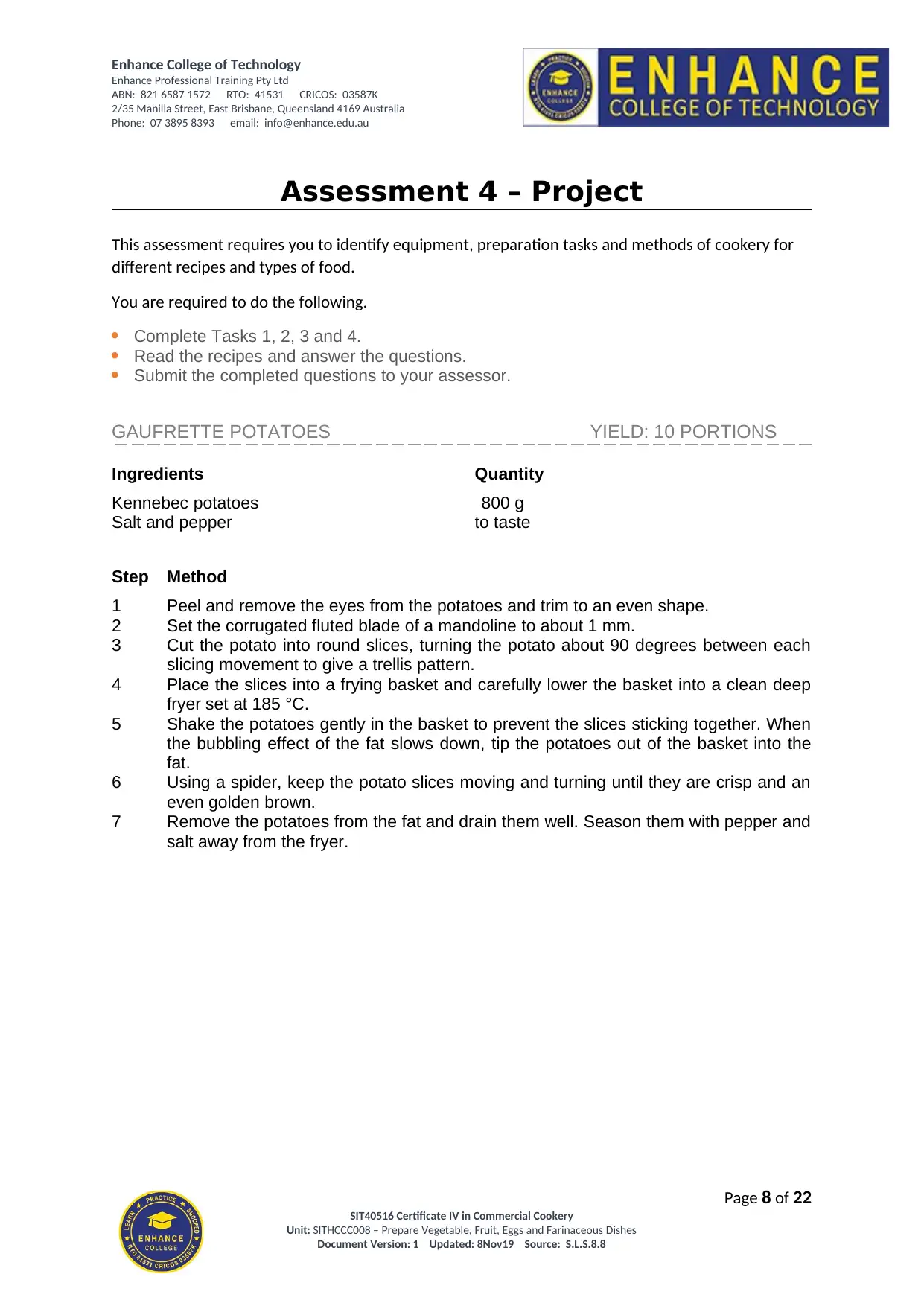
Enhance College of Technology
Enhance Professional Training Pty Ltd
ABN: 821 6587 1572 RTO: 41531 CRICOS: 03587K
2/35 Manilla Street, East Brisbane, Queensland 4169 Australia
Phone: 07 3895 8393 email: info@enhance.edu.au
Assessment 4 – Project
This assessment requires you to identify equipment, preparation tasks and methods of cookery for
different recipes and types of food.
You are required to do the following.
Complete Tasks 1, 2, 3 and 4.
Read the recipes and answer the questions.
Submit the completed questions to your assessor.
GAUFRETTE POTATOES YIELD: 10 PORTIONS
Ingredients Quantity
Kennebec potatoes 800 g
Salt and pepper to taste
Step Method
1 Peel and remove the eyes from the potatoes and trim to an even shape.
2 Set the corrugated fluted blade of a mandoline to about 1 mm.
3 Cut the potato into round slices, turning the potato about 90 degrees between each
slicing movement to give a trellis pattern.
4 Place the slices into a frying basket and carefully lower the basket into a clean deep
fryer set at 185 °C.
5 Shake the potatoes gently in the basket to prevent the slices sticking together. When
the bubbling effect of the fat slows down, tip the potatoes out of the basket into the
fat.
6 Using a spider, keep the potato slices moving and turning until they are crisp and an
even golden brown.
7 Remove the potatoes from the fat and drain them well. Season them with pepper and
salt away from the fryer.
Page 8 of 22
SIT40516 Certificate IV in Commercial Cookery
Unit: SITHCCC008 – Prepare Vegetable, Fruit, Eggs and Farinaceous Dishes
Document Version: 1 Updated: 8Nov19 Source: S.L.S.8.8
Enhance Professional Training Pty Ltd
ABN: 821 6587 1572 RTO: 41531 CRICOS: 03587K
2/35 Manilla Street, East Brisbane, Queensland 4169 Australia
Phone: 07 3895 8393 email: info@enhance.edu.au
Assessment 4 – Project
This assessment requires you to identify equipment, preparation tasks and methods of cookery for
different recipes and types of food.
You are required to do the following.
Complete Tasks 1, 2, 3 and 4.
Read the recipes and answer the questions.
Submit the completed questions to your assessor.
GAUFRETTE POTATOES YIELD: 10 PORTIONS
Ingredients Quantity
Kennebec potatoes 800 g
Salt and pepper to taste
Step Method
1 Peel and remove the eyes from the potatoes and trim to an even shape.
2 Set the corrugated fluted blade of a mandoline to about 1 mm.
3 Cut the potato into round slices, turning the potato about 90 degrees between each
slicing movement to give a trellis pattern.
4 Place the slices into a frying basket and carefully lower the basket into a clean deep
fryer set at 185 °C.
5 Shake the potatoes gently in the basket to prevent the slices sticking together. When
the bubbling effect of the fat slows down, tip the potatoes out of the basket into the
fat.
6 Using a spider, keep the potato slices moving and turning until they are crisp and an
even golden brown.
7 Remove the potatoes from the fat and drain them well. Season them with pepper and
salt away from the fryer.
Page 8 of 22
SIT40516 Certificate IV in Commercial Cookery
Unit: SITHCCC008 – Prepare Vegetable, Fruit, Eggs and Farinaceous Dishes
Document Version: 1 Updated: 8Nov19 Source: S.L.S.8.8
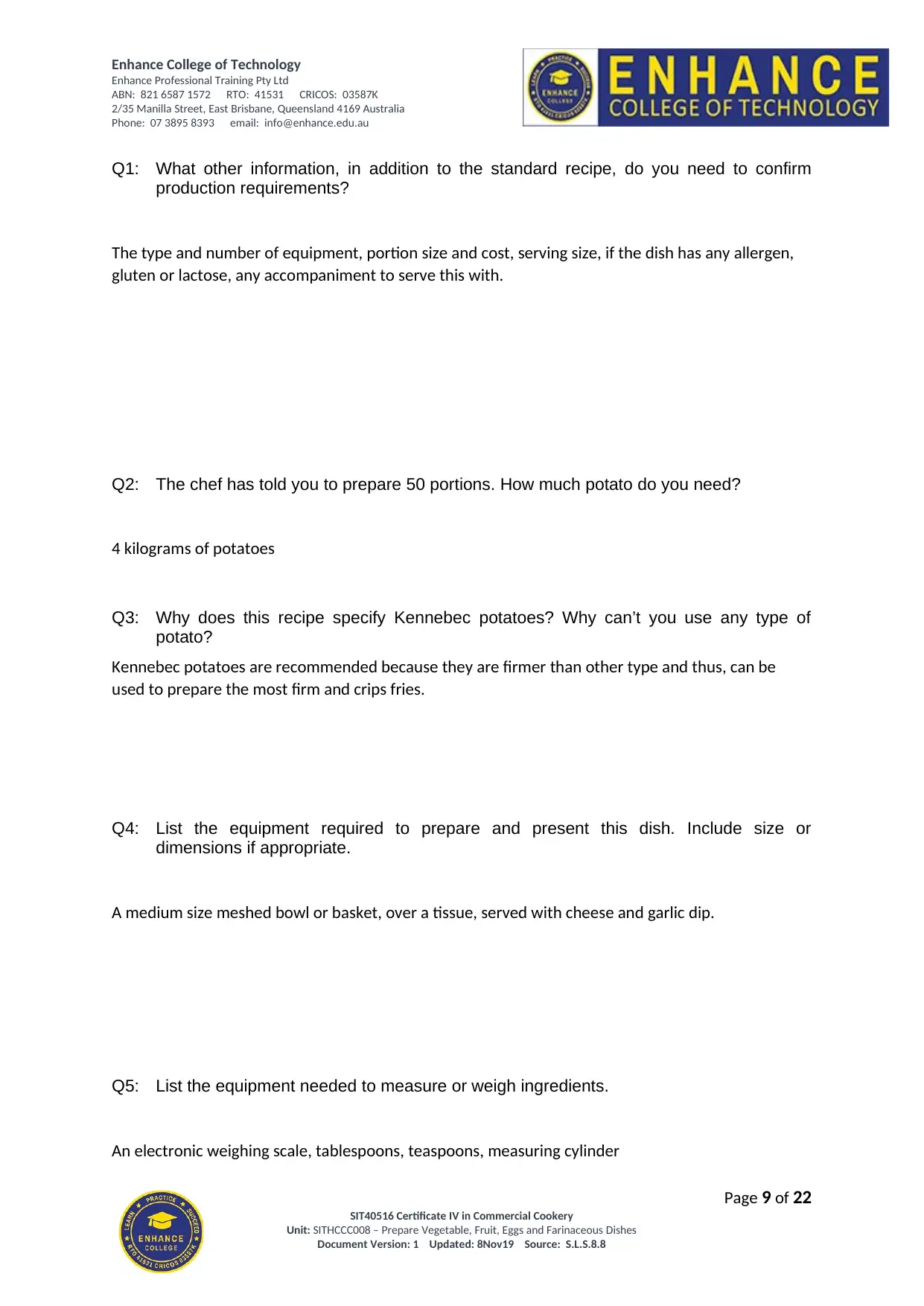
Enhance College of Technology
Enhance Professional Training Pty Ltd
ABN: 821 6587 1572 RTO: 41531 CRICOS: 03587K
2/35 Manilla Street, East Brisbane, Queensland 4169 Australia
Phone: 07 3895 8393 email: info@enhance.edu.au
Q1: What other information, in addition to the standard recipe, do you need to confirm
production requirements?
The type and number of equipment, portion size and cost, serving size, if the dish has any allergen,
gluten or lactose, any accompaniment to serve this with.
Q2: The chef has told you to prepare 50 portions. How much potato do you need?
4 kilograms of potatoes
Q3: Why does this recipe specify Kennebec potatoes? Why can’t you use any type of
potato?
Kennebec potatoes are recommended because they are firmer than other type and thus, can be
used to prepare the most firm and crips fries.
Q4: List the equipment required to prepare and present this dish. Include size or
dimensions if appropriate.
A medium size meshed bowl or basket, over a tissue, served with cheese and garlic dip.
Q5: List the equipment needed to measure or weigh ingredients.
An electronic weighing scale, tablespoons, teaspoons, measuring cylinder
Page 9 of 22
SIT40516 Certificate IV in Commercial Cookery
Unit: SITHCCC008 – Prepare Vegetable, Fruit, Eggs and Farinaceous Dishes
Document Version: 1 Updated: 8Nov19 Source: S.L.S.8.8
Enhance Professional Training Pty Ltd
ABN: 821 6587 1572 RTO: 41531 CRICOS: 03587K
2/35 Manilla Street, East Brisbane, Queensland 4169 Australia
Phone: 07 3895 8393 email: info@enhance.edu.au
Q1: What other information, in addition to the standard recipe, do you need to confirm
production requirements?
The type and number of equipment, portion size and cost, serving size, if the dish has any allergen,
gluten or lactose, any accompaniment to serve this with.
Q2: The chef has told you to prepare 50 portions. How much potato do you need?
4 kilograms of potatoes
Q3: Why does this recipe specify Kennebec potatoes? Why can’t you use any type of
potato?
Kennebec potatoes are recommended because they are firmer than other type and thus, can be
used to prepare the most firm and crips fries.
Q4: List the equipment required to prepare and present this dish. Include size or
dimensions if appropriate.
A medium size meshed bowl or basket, over a tissue, served with cheese and garlic dip.
Q5: List the equipment needed to measure or weigh ingredients.
An electronic weighing scale, tablespoons, teaspoons, measuring cylinder
Page 9 of 22
SIT40516 Certificate IV in Commercial Cookery
Unit: SITHCCC008 – Prepare Vegetable, Fruit, Eggs and Farinaceous Dishes
Document Version: 1 Updated: 8Nov19 Source: S.L.S.8.8
⊘ This is a preview!⊘
Do you want full access?
Subscribe today to unlock all pages.

Trusted by 1+ million students worldwide
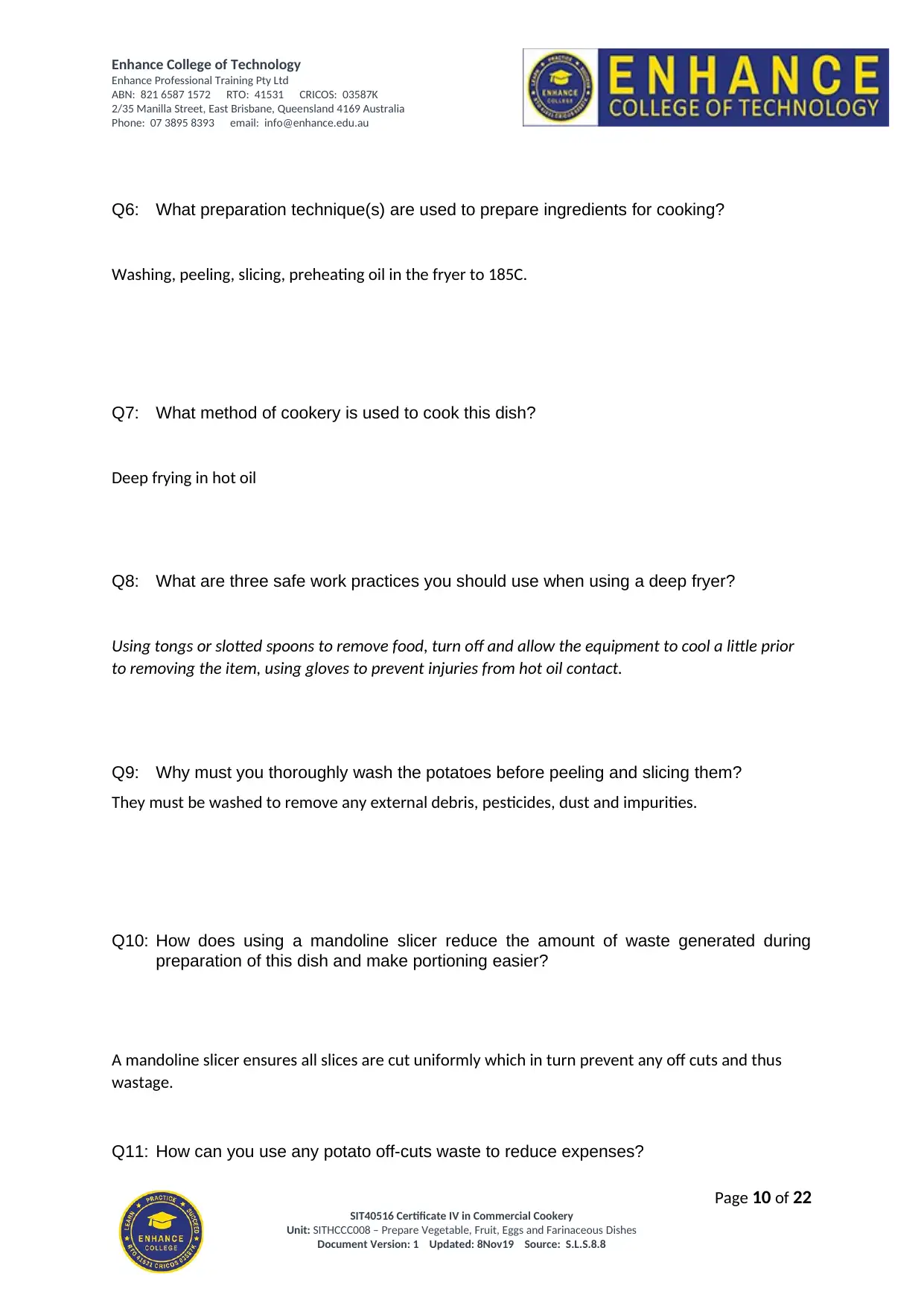
Enhance College of Technology
Enhance Professional Training Pty Ltd
ABN: 821 6587 1572 RTO: 41531 CRICOS: 03587K
2/35 Manilla Street, East Brisbane, Queensland 4169 Australia
Phone: 07 3895 8393 email: info@enhance.edu.au
Q6: What preparation technique(s) are used to prepare ingredients for cooking?
Washing, peeling, slicing, preheating oil in the fryer to 185C.
Q7: What method of cookery is used to cook this dish?
Deep frying in hot oil
Q8: What are three safe work practices you should use when using a deep fryer?
Using tongs or slotted spoons to remove food, turn off and allow the equipment to cool a little prior
to removing the item, using gloves to prevent injuries from hot oil contact.
Q9: Why must you thoroughly wash the potatoes before peeling and slicing them?
They must be washed to remove any external debris, pesticides, dust and impurities.
Q10: How does using a mandoline slicer reduce the amount of waste generated during
preparation of this dish and make portioning easier?
A mandoline slicer ensures all slices are cut uniformly which in turn prevent any off cuts and thus
wastage.
Q11: How can you use any potato off-cuts waste to reduce expenses?
Page 10 of 22
SIT40516 Certificate IV in Commercial Cookery
Unit: SITHCCC008 – Prepare Vegetable, Fruit, Eggs and Farinaceous Dishes
Document Version: 1 Updated: 8Nov19 Source: S.L.S.8.8
Enhance Professional Training Pty Ltd
ABN: 821 6587 1572 RTO: 41531 CRICOS: 03587K
2/35 Manilla Street, East Brisbane, Queensland 4169 Australia
Phone: 07 3895 8393 email: info@enhance.edu.au
Q6: What preparation technique(s) are used to prepare ingredients for cooking?
Washing, peeling, slicing, preheating oil in the fryer to 185C.
Q7: What method of cookery is used to cook this dish?
Deep frying in hot oil
Q8: What are three safe work practices you should use when using a deep fryer?
Using tongs or slotted spoons to remove food, turn off and allow the equipment to cool a little prior
to removing the item, using gloves to prevent injuries from hot oil contact.
Q9: Why must you thoroughly wash the potatoes before peeling and slicing them?
They must be washed to remove any external debris, pesticides, dust and impurities.
Q10: How does using a mandoline slicer reduce the amount of waste generated during
preparation of this dish and make portioning easier?
A mandoline slicer ensures all slices are cut uniformly which in turn prevent any off cuts and thus
wastage.
Q11: How can you use any potato off-cuts waste to reduce expenses?
Page 10 of 22
SIT40516 Certificate IV in Commercial Cookery
Unit: SITHCCC008 – Prepare Vegetable, Fruit, Eggs and Farinaceous Dishes
Document Version: 1 Updated: 8Nov19 Source: S.L.S.8.8
Paraphrase This Document
Need a fresh take? Get an instant paraphrase of this document with our AI Paraphraser
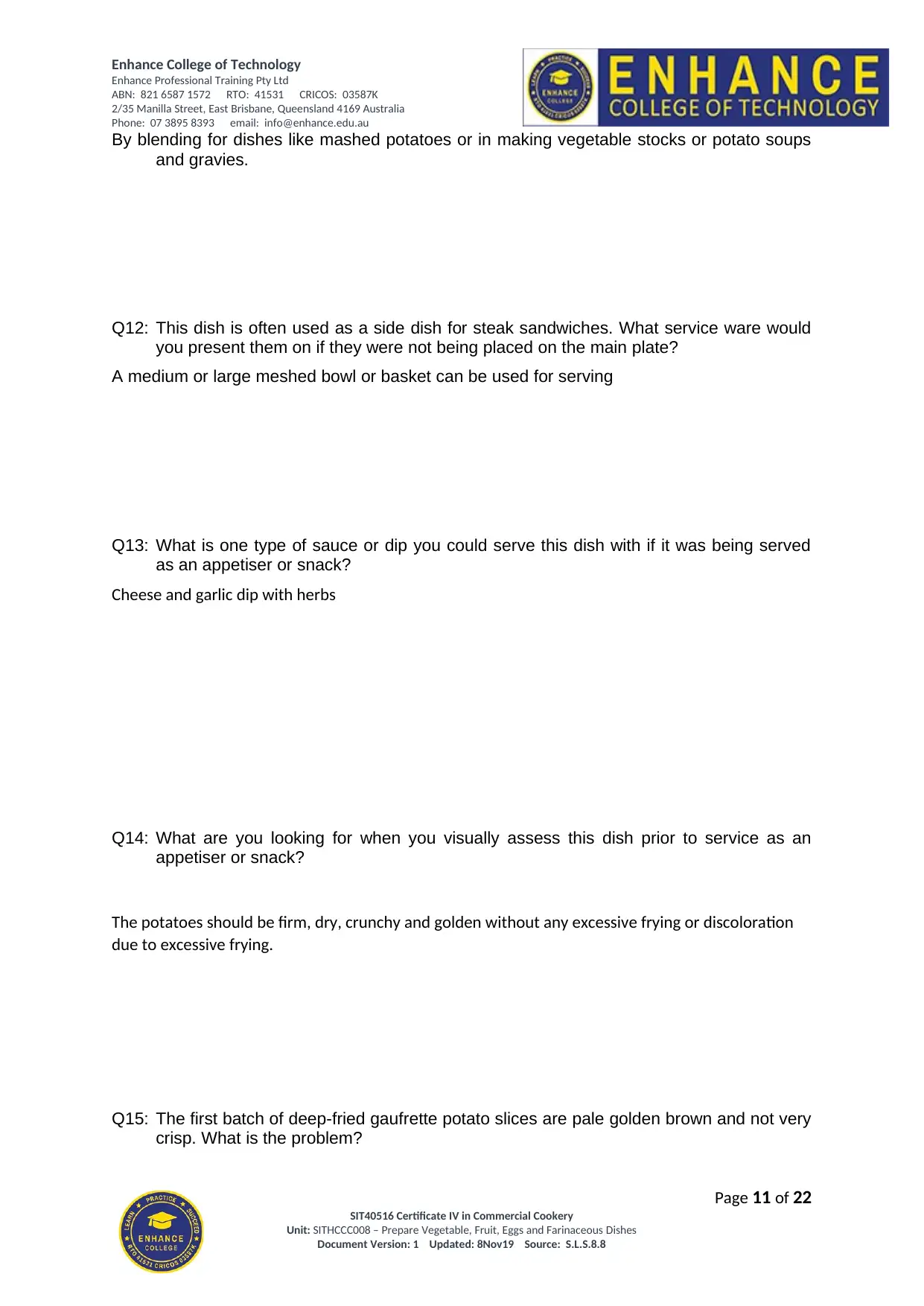
Enhance College of Technology
Enhance Professional Training Pty Ltd
ABN: 821 6587 1572 RTO: 41531 CRICOS: 03587K
2/35 Manilla Street, East Brisbane, Queensland 4169 Australia
Phone: 07 3895 8393 email: info@enhance.edu.au
By blending for dishes like mashed potatoes or in making vegetable stocks or potato soups
and gravies.
Q12: This dish is often used as a side dish for steak sandwiches. What service ware would
you present them on if they were not being placed on the main plate?
A medium or large meshed bowl or basket can be used for serving
Q13: What is one type of sauce or dip you could serve this dish with if it was being served
as an appetiser or snack?
Cheese and garlic dip with herbs
Q14: What are you looking for when you visually assess this dish prior to service as an
appetiser or snack?
The potatoes should be firm, dry, crunchy and golden without any excessive frying or discoloration
due to excessive frying.
Q15: The first batch of deep-fried gaufrette potato slices are pale golden brown and not very
crisp. What is the problem?
Page 11 of 22
SIT40516 Certificate IV in Commercial Cookery
Unit: SITHCCC008 – Prepare Vegetable, Fruit, Eggs and Farinaceous Dishes
Document Version: 1 Updated: 8Nov19 Source: S.L.S.8.8
Enhance Professional Training Pty Ltd
ABN: 821 6587 1572 RTO: 41531 CRICOS: 03587K
2/35 Manilla Street, East Brisbane, Queensland 4169 Australia
Phone: 07 3895 8393 email: info@enhance.edu.au
By blending for dishes like mashed potatoes or in making vegetable stocks or potato soups
and gravies.
Q12: This dish is often used as a side dish for steak sandwiches. What service ware would
you present them on if they were not being placed on the main plate?
A medium or large meshed bowl or basket can be used for serving
Q13: What is one type of sauce or dip you could serve this dish with if it was being served
as an appetiser or snack?
Cheese and garlic dip with herbs
Q14: What are you looking for when you visually assess this dish prior to service as an
appetiser or snack?
The potatoes should be firm, dry, crunchy and golden without any excessive frying or discoloration
due to excessive frying.
Q15: The first batch of deep-fried gaufrette potato slices are pale golden brown and not very
crisp. What is the problem?
Page 11 of 22
SIT40516 Certificate IV in Commercial Cookery
Unit: SITHCCC008 – Prepare Vegetable, Fruit, Eggs and Farinaceous Dishes
Document Version: 1 Updated: 8Nov19 Source: S.L.S.8.8
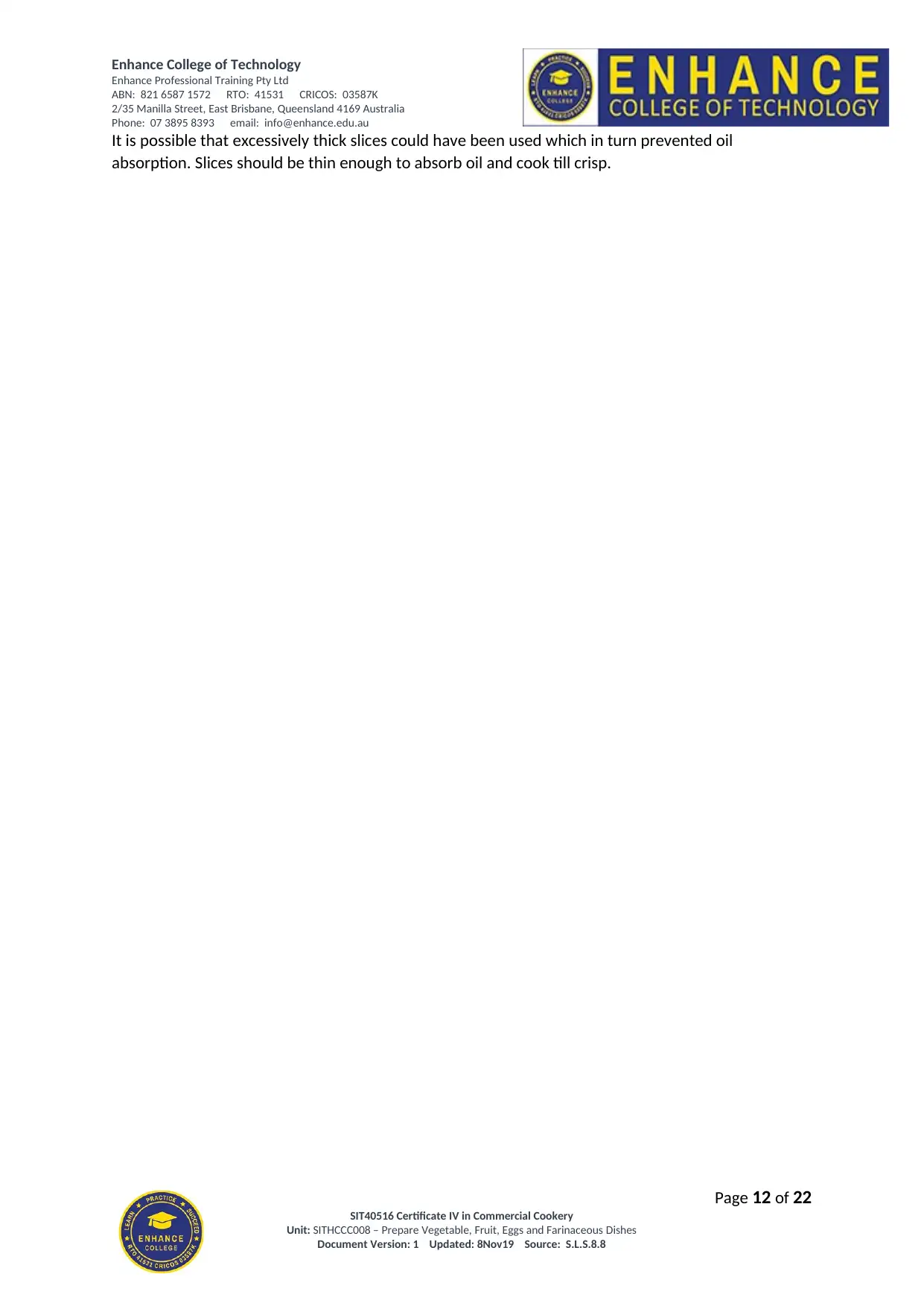
Enhance College of Technology
Enhance Professional Training Pty Ltd
ABN: 821 6587 1572 RTO: 41531 CRICOS: 03587K
2/35 Manilla Street, East Brisbane, Queensland 4169 Australia
Phone: 07 3895 8393 email: info@enhance.edu.au
It is possible that excessively thick slices could have been used which in turn prevented oil
absorption. Slices should be thin enough to absorb oil and cook till crisp.
Page 12 of 22
SIT40516 Certificate IV in Commercial Cookery
Unit: SITHCCC008 – Prepare Vegetable, Fruit, Eggs and Farinaceous Dishes
Document Version: 1 Updated: 8Nov19 Source: S.L.S.8.8
Enhance Professional Training Pty Ltd
ABN: 821 6587 1572 RTO: 41531 CRICOS: 03587K
2/35 Manilla Street, East Brisbane, Queensland 4169 Australia
Phone: 07 3895 8393 email: info@enhance.edu.au
It is possible that excessively thick slices could have been used which in turn prevented oil
absorption. Slices should be thin enough to absorb oil and cook till crisp.
Page 12 of 22
SIT40516 Certificate IV in Commercial Cookery
Unit: SITHCCC008 – Prepare Vegetable, Fruit, Eggs and Farinaceous Dishes
Document Version: 1 Updated: 8Nov19 Source: S.L.S.8.8
⊘ This is a preview!⊘
Do you want full access?
Subscribe today to unlock all pages.

Trusted by 1+ million students worldwide
1 out of 22
Related Documents
Your All-in-One AI-Powered Toolkit for Academic Success.
+13062052269
info@desklib.com
Available 24*7 on WhatsApp / Email
![[object Object]](/_next/static/media/star-bottom.7253800d.svg)
Unlock your academic potential
Copyright © 2020–2025 A2Z Services. All Rights Reserved. Developed and managed by ZUCOL.





